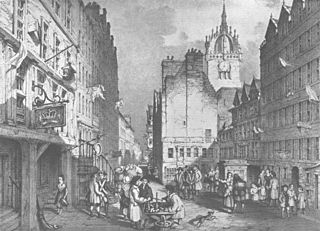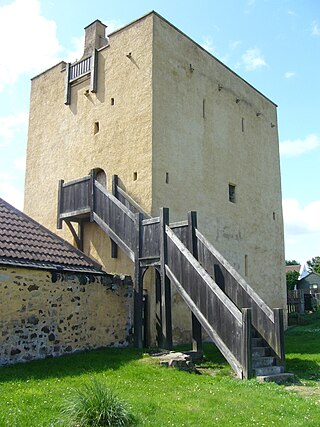Related Research Articles

Leith is a port area in the north of Edinburgh, Scotland, founded at the mouth of the Water of Leith.

Sir George Lockhart of Carnwath was a Scottish advocate, judge and commissioner to parliament who was murdered.
Robert Maxwell, 5th Lord Maxwell was a member of the Council of Regency (1536) of the Kingdom of Scotland, Regent of the Isle of Arran and like his father before him patriarch of the House of Maxwell/Clan Maxwell. A distinguished Scottish nobleman, politician, soldier and in 1513 Lord High Admiral, Lord Maxwell was a member of James V of Scotland's royal council and served as Lord Provost of Edinburgh in 1524, 1527 and 1535. He was also an Extraordinary Lord of Session in 1533. In 1537, he was one of the ambassadors sent to the French Court to negotiate the marriage of James to Mary of Guise, whom he espoused as proxy for the King.

The Canongate Kirkyard stands around Canongate Kirk on the Royal Mile in Edinburgh, Scotland. The churchyard was used for burials from the late 1680s until the mid-20th century.

Greyfriars Kirkyard is the graveyard surrounding Greyfriars Kirk in Edinburgh, Scotland. It is located at the southern edge of the Old Town, adjacent to George Heriot's School. Burials have been taking place since the late 16th century, and a number of notable Edinburgh residents are interred at Greyfriars. The Kirkyard is operated by City of Edinburgh Council in liaison with a charitable trust, which is linked to but separate from the church. The Kirkyard and its monuments are protected as a category A listed building.

Scottish renaissance painted ceilings are decorated ceilings in Scottish houses and castles built between 1540 and 1640. This is a distinctive national style, though there is common ground with similar work elsewhere, especially in France, Spain and Scandinavia. An example in England, at Wickham, Hampshire, was recorded in 1974. There are records of over 100 examples, and a much smaller number of painted ceilings survive in-situ today. Some salvaged painted beams and boards are stored by Historic Environment Scotland. The paintings at Crathes Castle, dating from 1597 and 1602 are probably the best known.
Sir James MacGill, Lord Rankeillor of Nether Rankeillour, was a Scottish courtier and Senator of the College of Justice.
Katherine Bellenden was a courtier working in the wardrobe of James V of Scotland. Her niece of the same name was similarly employed.
The Burning of Edinburgh in 1544 by an English army was the first major action of the war of the Rough Wooing. The Provost of Edinburgh was compelled to allow the English to sack Leith and Edinburgh, and the city was burnt on 7 May. However, the Scottish artillery within Edinburgh Castle harassed the English forces, who had neither the time nor the resources to besiege the Castle. The English fleet sailed away loaded with captured goods, and with two ships that had belonged to James V of Scotland.
Alexander Henderson of Press (c.1770–1826) was an 18th–19th century Scottish nurseryman and seed merchant, who was first Chairman of the National Bank of Scotland and Lord Provost of Edinburgh from 1823 to 1825.
Sir Robert Chieslie of Dalry was a Scottish merchant who served as Lord Provost of Edinburgh from 1694 to 1696.

Sir William Dick of Braid (1580–1655) was a 17th-century Scottish landowner, banker and merchant who served as Lord Provost of Edinburgh from 1638 to 1640. His fortunes took him from being "the richest man in Scotland" in 1650 to his death as a pauper a few years later.

Sir John Byres of Coates (1569–1629) was a 16th/17th century Scottish banker and merchant who served as Treasurer and Old Provost for Edinburgh Town Council. Old Provost is the equivalent of Deputy Provost.

William Little of Liberton (1525–1601) was a 16th-century Scottish merchant and landowner who served as Lord Provost of Edinburgh 1586/87 and 1591/92. He was one of the founders of Edinburgh University.
Thomas McCalzean, Lord Cliftonhall was a 16th-century Scottish judge, rising to be a Senator of the College of Justice and a local politician who was briefly Provost of Edinburgh in 1562 at the personal request of Mary Queen of Scots who sought a moderate influence during these troubled times.
Archibald Stewart of Mitcham MP (1697–1780) was an 18th-century Scottish merchant and politician who served as Lord Provost of Edinburgh during the critical Jacobite Rebellion of 1745. He was imprisoned in the Tower of London for over a year owing to his alleged negligence.
John Wightman of Mauldslie (c.1670–1740) was an 18th-century Scottish merchant who served as Lord Provost of Edinburgh from 1721 to 1723.
William Trotter of Ballindean JP DL (1772–1833) was a Scottish cabinet-maker who served as Lord Provost of Edinburgh from 1825 to 1827.
John Hope was a French courtier and merchant who settled in Edinburgh.
George Sinclair, Lord Woodhall also known as George Sinclair of Castlehill (c.1700–1764) was a Scottish judge and Senator of the College of Justice.
References
- ↑ "Appendix: Lists of provosts, bailiffs and other officers | British History Online".
- ↑ Edinburgh City Chambers: Lord Provosts of Edinburgh
- ↑ Scotsman (newspaper) 18 July 2018
- ↑ "Edinburgh-Royal Mile History Castle Hill page5".
- ↑ Old Edinburgh Club: The Closes of Edinburgh by Charles Boog Watson
- ↑ "Edinburgh, 533 Castlehill, Palace and Chapel of Mary of Guise | Canmore".